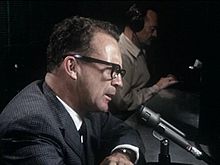Ernestine Rose became the first woman to address the Michigan legislature when she spoke to the all-male body about women’s suffrage.
The rest of the story:
Ernestine Rose — Polish-born feminist, atheist, and abolitionist who had relocated to New York — spoke twice to the state House of Representatives in Michigan.
She spoke “on the science of government.” The lecture is well received and the House passes a second resolution granting Mrs. Rose the use of the House of Representatives the following evening for a second lecture on “the antagonistical principles of society.” Both lectures were likely on women’s rights and the lack of protection afforded to women under the law.
Her talks are remembered both as the first time a woman spoke to the Legislature and for bringing the question of female suffrage to the state.
The Daily Advertiser urged residents to go hear her speak, noting that they “will be gratified to ascertain that talent and genius are not confined to the stronger sex.”
Sources :
Michigan Historical Calendar, courtesy of the Clarke Historical Library at Central Michigan University.
Michigan Historical Review Facebook Page, March 24, 2017.
Ernestine Rose wikipedia entry
Michigan Women’s Historical Center and Hall of Fame Historical Timeline
Rebels and reformers : biographies of four Jewish Americans : Uriah Phillips Levy, Ernestine L. Rose, Louis D. Brandeis, Lillian D. Wald / by Alberta Eiseman ; illustrated by Herb Steinberg.
The American life of Ernestine L. Rose / Carol A. Kolmerten.
Ernestine L. Rose and the battle for human rights / Yuri Suhl.
Eloquent crusader: Ernestine Rose / Yuri Suhl.
In the little country village of Niles, a thousand people crowded the main four corners on May 4, 1861 to see a magnificent flag presented to the Berrien County Volunteers. The 88 infantry volunteers, somestimes called roughnecks or mudsills, carried the flag with them on the Michigan Central Railroad on their way to Detroit. There it was adopted as the regimental flag of the Second Michigan Infantry, and the Volunteers became Company E, the color company of that regiment. The flag was carried proudly at the Battles of Blackburn’s Ford, First Bull Run, the Yorktown siege, Williamsburg, Fair Oaks, Malvern Hill, Second Bull Run, Chantilly and Fredericksburg. At that point it was returned to the ladies of Niles since with forty bullet holes in it, it was too tattered for further use. By then 11 of the original 88 volunteered were dead.
Source : Twice Told Tales of Michigan and Her Soldiers in the Civil War, Michigan Civil War Centennial Observance Commission, 1966, pp. 5-7.
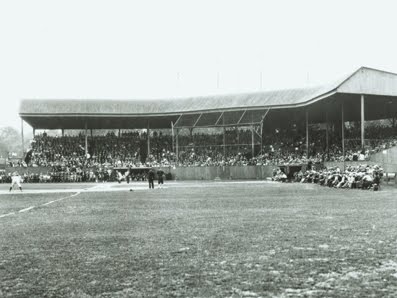
Marsh Field has been home to Muskegon Baseball for nearly 100 years. Charles W. Marsh purchased four square blocks of property in the center of town at the corner of Peck Street and Laketon Avenue in February of 1916.
The architect firm of Harry Boyle & Company of Evansville, Indiana was given the contract to design the modern era baseball facility. Charles W. Marsh contracted Nelson & Mayson to build the grandstand and so was the beginning of baseball at Marsh Field. The park would not only provide a fully equipped grandstand and baseball field, but part of the property would serve as a combination children’s playground and picnic area.
On May 4, 1916 the Muskegon Reds played the first game at Marsh Field against the Terre Haute Highlanders. Since that time, many baseball teams have called Marsh Field home. Teams like the Reds, the Clowns, the Clippers, the Lassies, the Zephyrs and the Muskegon high school Big Reds. Prep summer teams like Durham Chiropractic and the Muskegon ChannelCats have also enjoyed playing at this old diamond.
In 2010, a group of citizens led by Len Piasecki and Pete Gawkowski took over the operation of the field from the City of Muskegon, and developed the Lakeshore Baseball Club. This public-private partnership has garnered positive media attention and praise throughout the community.
|
||||
| Source: Marsh Field website. Still available thanks to the Internet Archives. | ||||

Don Edwin Coleman (May 4, 1928 – January 30, 2017) was an American football player. Coleman played high school football at Flint Central High School and college football at Michigan State University. He was a unanimous All-American in 1951, the first African American All-American football player at Michigan State, and the first Michigan State player to have his jersey number retired by the school. In 1968, he also became the first African-American to serve on the coaching staff at Michigan State. Coleman was elected to the College Football Hall of Fame in 1975.
Born in Oklahoma, Coleman moved with his family to Flint, Michigan before his freshman year in high school. Coleman did not play football until his senior year at Flint Central High School. Two of Coleman’s older brothers had died in their youth, one from drowning and the other from pneumonia. Coleman’s mother did not want her youngest son to be injured playing football. Accordingly, Coleman played No.1 trumpet in the high school band and competed in swimming for three years. When Flint Central had a swim meet with Royal Oak High School, the Royal Oak coach “made it known Coleman would not be allowed to swim because a black swimmer had never been in their pool.” Flint Central swim coach, Bob Richardson, stood behind Coleman and told the Royal Oak coach that, “if Don Coleman couldn’t swim, then the rest of the Flint Central team would not swim.” Coleman became the first black swimmer to enter Royal Oak’s pool.
As a senior in 1947, Coleman’s mother finally agreed to allow her son to play football. In his first year of football, he was selected as an all-state guard and led Flint Central to the state championship.
After graduating from Flint Central, Coleman enrolled at Michigan State University, then known as Michigan State College. He played principally at the tackle position for Biggie Munn’s Michigan State Spartans from 1949 to 1951. At 178 pounds, he was the lightest player on the 1949 Michigan State football team. Coleman made up for what he lacked in size with quickness and intensity. Long-time Michigan State sports information director Fred Stabley in 1972 named Coleman as one of the two best players he saw at Michigan State and recalled that, despite his size, Coleman was “so quick and played with such intensity. He loved to play against big men. The 250 pounders were his meat.” In 1952, the Chicago Daily Tribune wrote that Coleman “probably is packed with more football per pound than any man in the United States.”
Coleman was also Michigan States’s first unanimous All-American football player and its first African-American All-American. Michigan State under Biggie Munn and Duffy Daugherty earned a reputation as one of the leaders in racial integration of football, and Coleman was the first of many great African-American stars to play for the Spartans. In 1953, a feature story on racial integration of football cited the example of Coleman:
“In 1951, for instance, as for two years previously, their watch-charm tackle, Don Coleman, was one of the world’s best football players. Weighing only 180 pounds, Coleman employed quickness, agility, brains and courage to win unanimous selection as an All-American in 1951. At Michigan State, he is perpetually nominated as one of the greatest football players of all time.”
As a senior year in 1951, Coleman was selected as the Most Valuable Player on the undefeated 1951 Michigan State Spartans football team and received the Governor of Michigan Award. In presenting Coleman with the award, Michigan Governor Mennen Williams said, “A couple of those tackles I saw you make in the Notre Dame game were enough to convince me.” Coleman was credited with being the key to the Michigan State offense in 1951. Line coach Duffy Daugherty pointed to a Coleman blocks in the Marquette game as “one of the greatest plays by an offensive lineman that I’ve ever seen.” According to Daugherty, Coleman was knocked to the ground, but got up, caught and passed the Michigan State ball carrier (Leroy Bolden) and “still made the key block that let him go for 33 yards.” Daugherty later credited Coleman with “changing the concept of offensive football at Michigan State” and added, “He gave me a lesson which made football a winning proposition at the school for ten of the next twelve years.”> Daugherty went even further in 1954 with the following words of praise for Coleman:
“If you want to pick a player on the basis of how close to perfection he is in whatever position he plays, I’ll say Coleman was the greatest.”
Although recruited by the St. Louis Cardinals, Coleman was drafted by the U.S. Army in 1952 and served during the Korean War. After being discharged, Coleman was signed by the Cardinals but was almost immediately traded to the Green Bay Packers. Coleman declined to make the move, and instead returned to Flint to become the first African American school teacher at Flint Central High School, and eventually became the Dean of Students at the school.
In April 1968, Coleman left his position as a school principal in Flint to join Duffy Daugherty’s coaching staff as an assistant coach. He was the first AfricanAmerican on Michigan State’s coaching staff. That same month, a group of African-American athletes at Michigan State had announced plans to boycott all sports at the university in protest against the lack of African-Americans in coaching, counseling and administration positions. According to a report in the Washington Afro-American, Michigan State was forced to leave its “lily-white hiring” by the “quiet but firm demands of a militant, forward looking student organization. Coleman resigned his coaching position at Michigan State in January 1969 and accepted a new position in the school’s residence hall program. At the time of his resignation, Coleman said, “Frankly, I found football coaching was not for me … During the years I had been out of football, the game had changed so drastically that I feel lost.” After his resignation from the coaching staff, Coleman held ten different assignments at Michigan State, including assistant dean of the graduate school, counselor and director of minority comprehensive support programs at the Michigan State College of Osteopathic Medicine, and professor emeritus.
Coleman was the first Michigan State football player to have his number retired. On December 14, 1951, Biggie Munn announced that Coleman’s No. 78 would never again be used on a Spartan uniform. An executive from General Motors presented Coleman with a check for $500 on behalf of the people of Flint, Michigan.
Coleman has also received numerous other honors and awards, including the following:
- Coleman was one of the charter members of the Flint Hall of Fame.
- In January 1970, Coleman was named to the All-Time Michigan State football team based on ballots collected by the Michigan State Alumni Magazine and Michigan State News. He was also named as the best all-time interior lineman in Michigan State history.
- In January 1971, Coleman was named to the all-time Hula Bowl team and was named as the outstanding college lineman in the 25-year history of the Hula Bowl.
- In February 1975, Coleman was inducted into the College Football Hall of Fame. At the time of his induction, Coleman was working as a counselor and director of minority comprehensive support programs in the MSU College of Osteopathic Medicine. On learning of the honor, Coleman said, “This is the greatest honor I’ve ever received.”
- In 1992, Coleman was a charter inductee into the Michigan State Hall of Fame.
- In December 1996, Coleman was selected by the Michigan Hall of Fame as the recipient of its second annual Legends Award.
Coleman died on January 30, 2017, at age 88.
The very first Highway Travel Information center in the Unites States opened on May 4, 1935 on US-12 at New Buffalo in Berrien County. The structure was built by the Michigan State Highway Department (now M-DOT) to welcome motorists entering from Indiana. Similar travel centers soon began popping up across the nation and there are several hundred still in existence today.
Source: Brandon James, “A ‘Pure’ History Of Michigan Tourism Campaigns“, Magic 104.9, April 17, 2018.
“Soldiers are Cutting Us Down; Four Dead in Ohio, Including a Former MSU Student”
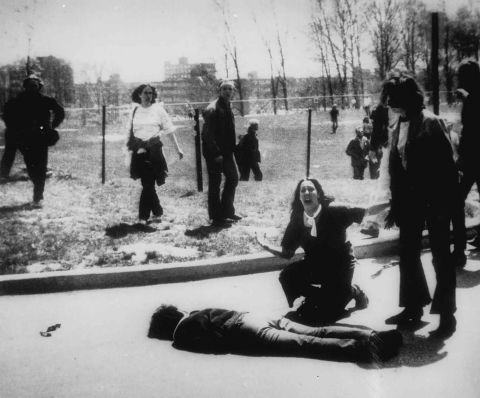
In this Pulitzer Prize-winning photo, taken by Kent State photojournalism student John Filo, Mary Ann Vecchio can be seen screaming as she kneels by the body of a slain student, Jeffrey Miller — a former MSU student on May 4, 1970 in an event commonly called the ‘Kent State Massacre’ . Miller had transferred to Kent State only four months earlier.
Students were protesting the Vietnam war spilling into Cambodia and the U.S. involvement. It was called a peace rally but after 4 days of student unrest and some rioting, the Ohio National Guard ended up firing almost 70 rounds of ammunition. Out of approximately 300 students at the rally, 13 were shot and four were killed.
According to cincinnati.com, “In 1968, (Jeffrey) followed his big brother to Michigan State University and even joined his fraternity, Phi Kappa Tau. He studied architecture, played it straight, and dressed in buttoned-down shirts and slacks”.
The article continued, “In August, Jeff joined 400,000 other young people at music festival Woodstock…..When he went back to Michigan State in the fall, he quit the fraternity, and changed his major to psychology”.
After MSU’s winter break, Miller decided to move on, since his brother had graduated from MSU and wasn’t around anymore. Jeffrey decided to transfer to Kent State in early 1970.
On April 30, President Nixon announced the Cambodia involvement.
May 1, protests and demonstrations began at Kent State. As nighttime approached, some rioting occurred, with broken windows, a street fire, and objects being thrown at police.
May 2, more protests and the National Guard was brought in.
May 3, some cleanup was attempted, but eventually more vandalism took place, with the National Guard dispensing tear gas.
Monday, May 4, a planned protest began at noon on campus. After students began throwing tear gas back at the soldiers, they were chased out of the area…at 12:24 pm the shots were fired and four students lay dead.
On the heels of this event, around four million college students throughout the country went on strike and walked out of classes and off campus.
There is much, much more to this historic event, and you can read all about it HERE. In reading this, you may see the similarities of what’s going on in our country now…..fifty years later.
Source : John Robinson, “Former MSU Student Killed at Kent State 50 Years Ago “, 99.1 WFMK, June 29, 2020.
The Kent State Massacre Photos courtesy of CNN
The Lansing State Journal, April 29, 1970 reports that Elton John will be performing at the Jenison Field House. Tickets are only $4 or $5 depending on location.
US 12 is now the only U.S. highway route still serving downtown Detroit, whose street grid was laid by Augustus B. Woodward, to have a five-way intersection of the roads that would become US 12, US 10, US 16, US 112 and US 25. US 24 still travels through Detroit from Puritan to 8 Mile Road on the far-west-side.
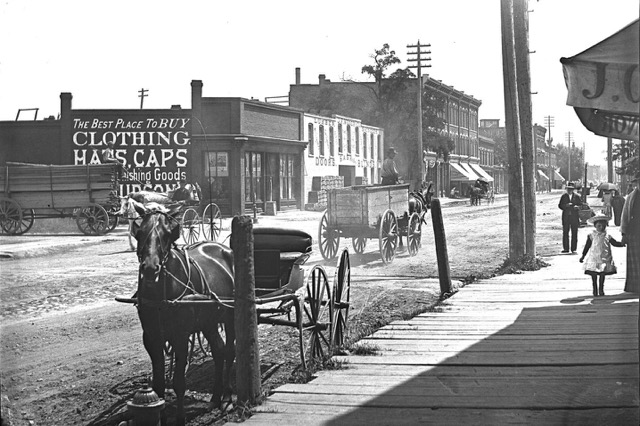
Michigan Avenue (year unknown) – From the Burton Historical Collection
As from the earliest days of its existence, US 12 enters Michigan from Indiana, southwest of New Buffalo and continues to the old junction of US 12 and US 112 in New Buffalo. It is now assigned between New Buffalo and Detroit (except through Ypsilanti), along what was US 112 until 1962.
On May 4, 2004, the Michigan Department of Transportation (MDOT) designated 209 miles (336 km) of US-12 from New Buffalo to Detroit as a Historic Heritage Route. The east-west corridor traverses the counties of Berrien, Cass, St. Joseph, Branch, Hillsdale, Lenawee, Washtenaw and Wayne. MDOT’s Heritage Route Committee has approved the route’s nomination as a premier addition to the Michigan Heritage Route Program.
US-12 is among the oldest road corridors east of the Mississippi River and accesses some of the most extensive and significant historic, cultural, scenic and recreational resources in Michigan. It begins in downtown Detroit, just blocks from the Detroit River, and extends through southern Michigan to the Michigan/Indiana border south of New Buffalo. It was originally a network of centuries-old trails created by Native Americans. Over the years it has had many names such as Sauk Trail, Chicago Road, and Michigan Avenue.
Believe it or not, but U.S. 12 was extended many times and now reaches the Pacific Ocean in the State of Washington.
Source : U.S. 12 Wikipedia entry
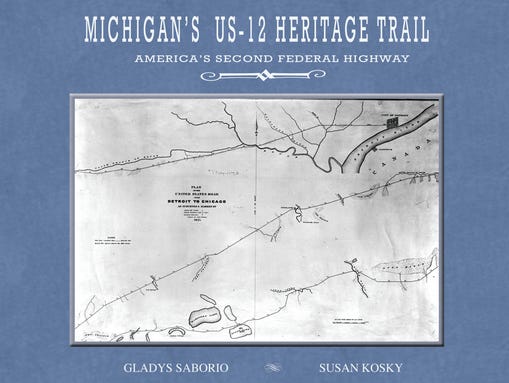
A fascinating new book traces U.S.-12 — Michigan Ave, if you’re a resident of metro Detroit or Chicago — from its days as an Indian trail to when it became the second U.S. federal highway in 1825 and its current status as a scenic and leisurely alternative to the sameness of interstate highways.
The book is packed with facts and hundreds of photos.
Michigan Avenue begins at Campus Martius in downtown Detroit — grab a coney dog for the road at the famed Lafayette or American coney island restaurants — but the authors suggest the route really begins a couple of miles away, where St. Anne’s parish was established July 26, 1701, two days after the landing of French explorer Antoine Laumet de la Mothe, sieur de Cadillac.
The route carried heavy traffic millennia before that.
A mastodon trail parallels U.S.-12 from Washtenaw County nearly to the Indiana state line. It’s the longest mastodon trail ever found, part of the reason the mastodon was named Michigan’s state fossil in 2002.
Just about every page delivers interesting information, including the fact that U.S.-12 was packed with whiskey smugglers carrying booze from Detroit’s Purple Gang to Al Capone’s organization during Prohibition in the 1920s and ’30s.
Congress appropriated $3,000 to create the nation’s second federal highway from Detroit to Chicago in 1825.
Cited book : Gladys Sabario and Susan Kosky, Michigan’s U.S. 12 Heritage Trail : America’s Second Federal Highway, Arbutus Press, 2015.
For the full article, see Mark Phelan, “U.S.-12 from mastodon trail to today, in words and photos”, Detroit Free Press, June 28, 2015.
Aaron Mondry, “Michigan’s highway: The history of Michigan Avenue, our state’s most important road“, Model D, March 6, 2017.
For a related story, see August 25, 1992 : New York Times Reports Discovery of Saline Michigan Mastodon Trail, Red Tape Blog.
For another, see March 2, 1824 : Father Gabriel Richard Petitions Congress. First Michigan Earmark?, Red Tape Blog.
On this day broadcasting legend Ernie Harwell, one of Detroit and Michigan’s most beloved sports figures, died. Harwell announced Detroit Tiger games on radio for 42 years.
Upon his death, he donated his massive sports memorabilia collection to the Detroit Public Library.
Source : Bill Loomis, On This Day in Detroit History, 2016.
Baptiste Turpin and Margaret Fafard marry at St. Anne’s Church, the oldest recorded marriage in Detroit. Fire destroyed records of the church in 1703 so it is possible that a marriage might have occured earlier, but there is no surviving record.
Source : The Detroit Almanac.


